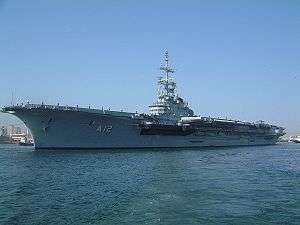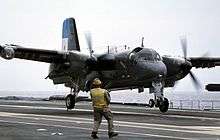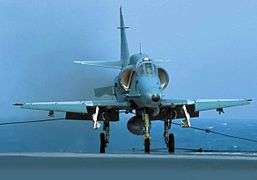Brazilian aircraft carrier São Paulo (A12)
 | |
| History | |
|---|---|
| Name: | Foch |
| Ordered: | 1955 |
| Laid down: | 15 November 1957 |
| Launched: | 23 July 1960 |
| Commissioned: | 15 July 1963 |
| Decommissioned: | 15 November 2000 |
| Identification: | R99 |
| Fate: | Sold to the Brazilian Navy |
| Name: | São Paulo |
| Namesake: | State of São Paulo |
| Launched: | 1960 by France |
| Acquired: | September 2000 |
| Commissioned: | 15 November 2000 |
| Identification: | Pennant number: A12 |
| Status: | Undergoing repairs[1] |
| Notes: | see Foch (R99) for prior history |
| General characteristics | |
| Class and type: | Clemenceau-class aircraft carrier |
| Displacement: |
|
| Length: | 265 m (869 ft) |
| Beam: | 31.7 m (104 ft) |
| Draught: | 8.60 m (28.2 ft) |
| Propulsion: | 6 Indret boilers, 4 steam turbines producing 126,000 hp, 2 propellers |
| Speed: | 32 knots (59 km/h) |
| Range: | 7,500 nautical miles (13,900 km) at 18 knots |
| Complement: | 1,338 men (1,920 including the air group). 984 men if only helicopters are carried. |
| Electronic warfare & decoys: |
|
| Armament: | four 100 mm turrets, two SACP Crotale EDIR systems, five 12.7 mm machine guns, 4 dual Simbad launchers |
| Aircraft carried: | 39 aircraft: 22 jets and 17 helicopters.[2] A-4KU Skyhawks, AS 532 SC Cougars, HB 350 & HB.355 Ecureuils, and SH-3 Sea Kings |
NAe[lower-alpha 1] São Paulo is a Clemenceau-class aircraft carrier currently in service with the Brazilian Navy. São Paulo was first commissioned in 1963 by the French Navy as Foch and was transferred in 2000 to Brazil, where she became the new flagship of the Brazilian Navy. In December 2014 it was announced that São Paulo will be expected to continue active service until 2039, at which time the vessel will be nearly 80 years old. IHS Janes reported that during its career with the Brazilian Navy, São Paulo has suffered from serviceability issues and has never managed to operate for more than three months at a time without the need for repairs and maintenance.[3]
Background
The aircraft carrier São Paulo was built in France between 1957 and 1960, and served in the French Navy as Foch. In September 2000, she was purchased by Brazil for US$30 million — no aircraft were included in the price — to replace the aged World War II-era carrier Minas Gerais, which had been in commission for over 40 years. Brazil had previously approached other countries, such as Spain, who wanted to construct a US$500 million carrier for Brazil, about the acquisition of a carrier.[4] The government had already purchased a flotilla of 23 used A-4 Skyhawk fighter planes from Kuwait for $70 million;[5] these planes, along with existing helicopters already in the national defense inventory, were to compose the São Paulo fighter-bomber group. These A-4s (designated AF-1) are capable of carrying armament including rockets, free-fall bombs, and Sidewinder air-to-air missiles.
The Clemenceau-class aircraft carriers, of which São Paulo is the last surviving member, are of conventional CATOBAR design. The flight deck is 265.5 metres (871 ft) long by 29.5 metres (97 ft) wide; the landing area is angled at 8 degrees off of the ship's axis. The forward aircraft elevator is to starboard, and the rear elevator is positioned on the deck edge to save hangar space. The forward of two 52-metre (171 ft) catapults is on the bow to port; the second catapult is farther back on the angled landing deck. The hangar deck dimensions are 152 metres (499 ft) by 22 to 24 metres (72 to 79 ft) with 7 metres (23 ft) overhead.[6]
In September 2000, São Paulo was purchased while still operational,[5] an unusual process for such a large ship. She was received by the Brazilian Navy and was incorporated into the Brazilian Navy on 15 November 2000. The incorporation of São Paulo and the AF-1 fighter group marked the realization of Brazil's long-held goal of being able to conduct aerial defense of its naval forces with fixed-wing aircraft.
President Fernando Henrique Cardoso noted during the transfer ceremony that:
The transfer of the aircraft carrier São Paulo to the Operative Sector of the Navy adds to our naval power an important magnification in its ability of defense of the Brazilian interests at sea. A country as ours, possessing an extensive coast, with more than 7,000 kilometers of coast, requires a naval power compatible with its stature in the international scene. Today, as before, Brazil is concerned about implementing concrete measures that offer the nation the guarantee of respect to its sovereignty. We are and we will always be a nation that fights for peace, however, that does not mean being able to do without modern Armed Forces, enabled and endowed with adequate dissuasive potential. Few countries, even today, have the capacity to operate with efficiency in the high seas. It is important that Brazil continues to be one of them."[7]
Since her construction, São Paulo has received multiple upgrades, leaving her with a diverse range of technologies. In her current form, she is expected to remain effective in her role for the foreseeable future, though further modernization efforts are expected as she is converted into a combat-ready vessel.
The carrier arrived in Rio de Janeiro on 17 February 2001.[5]
Brazilian service

In her first three years of service as São Paulo, the ship completed several missions, some in foreign waters, particularly Operations ARAEX,[8] PASSEX, and TEMPEREX,[9] which is used annually to qualify and train the Argentine Navy's Super Étendards and S-2T Turbo Trackers.[10]
São Paulo currently serves mainly to train pilots to fly carrier operations. She is actively used for the qualification and re-qualification of rotary and fixed-wing pilots (with about 500 catapult launches), and she was used during the first Brazilian exercises to practice carrier-based attack missions.[11]
2004 fire
On 17 May 2004, an explosion took place in the steam network of the engine room.[12] The explosion initially killed one crew member and injured ten others. All casualties were airlifted by helicopter to the Marcilio Dias Naval Hospital, Rio de Janeiro. Two of the injured crew later died in hospital from their injuries. Cause of the explosion was a rupture in the vapor pipeline. After this accident, the Navy decided to undertake an extensive overhaul to repair and modernize the ship.[13]
Upgrade (2005–10) and sea trials

.jpg)
During 2005–10, São Paulo underwent extensive modernization.[11] The upgrade included inspection and repair of the steam turbines; maintenance of the surface condensers; retubing of boilers; repair of two high-pressure compressors; revision of the AC electrical generator; purchase of spare parts; maintenance of pumps, valves, and structural items; addition of two API oil-water separators; installation of two water cooling units; upgrade of the chemical oxygen generator; repair and treatment of oil tanks; substitution of the Naval Tactical Data System; installation of a closed-circuit television system; installation of an IFF transponder; installation of a MAGE system (ESM); flight deck inspection, repair, and painting; upgrade of the Optical Landing System processing unit; and revision of the aircraft catapults.[14] The upgrade was completed in July 2009, and the São Paulo was initially due to be fully operational by August 2010.[15]
Twelve Brazilian Navy A-4 Skyhawks were also scheduled to be upgraded by Embraer at a cost of $140 million.[16] The upgrade was similar to the ones done for the AMX and F-5EM aircraft of the Brazilian Air Force. The program included restoring the aircraft and their current systems, as well as implementing new avionics, radar (specifically the Elta 2032 radar system), power production, and autonomous oxygen generating systems. Possible weapons to be included in the upgrade were MAA-1B, Python 4, and Derby AAMS.
The Brazilian Navy contracted Marsh Aviation to convert four S-2T Turbo Trackers to an airborne early warning (AEW) configuration, and four more for tanking and Carrier Onboard Delivery duties.[17]
According to an article in the October 2010 issue of Air Forces Monthly, it has been confirmed that Brazil has purchased ex-Australian and ex-Uruguayan C-1 Trader airframes, for conversion into AEW planes and Tanker aircraft. All of the planes were to be upgraded to S-2T Turbo Tracker configuration with Honeywell TPE 331-14GR engines. The purchase included nine airframes, of which two were for tanker conversion to refuel the AF-1 Skyhawks, and three were for AEW. The rest were purchased as for spares or for cargo duties. The AEW radar requirement was to have a range of 250 miles at 25,000 feet. Operational lifespan for the airframes was to be 10 years. They were expected to be ready in 2011 and 2012.[18]
São Paulo's SH-3 helicopter fleet was to be replaced by six S-70B Seahawk helicopters. They were purchased in 2008, upgraded, and refurbished for delivery. The helicopters and a package of engines and support equipment were scheduled for delivery in 2009.[19]
At the end of 2010, sea trials began, and as of 2011 São Paulo had been evaluated by the CIASA (Inspection Commission and Training Advisory).
Refit (2012 - present)
São Paulo was expected to rejoin the fleet in late 2013, but suffered another major fire in 2012.[20] As of September 2016, she continued to undergo repairs; the commander of the Brazilian Navy, Admiral Eduardo Leal Ferreira, said plans were in place to renew the carrier's propulsion system. The ship's catapult was also reported to have issues.[21]
Crew
São Paulo's complement is 1,920 (the ship's company is 64 officers and 1274 sailors, with an additional 582 in the air group).[22]
Gallery
 São Paulo (foreground) and USS Ronald Reagan (CVN-76) during a combined training exercise in June 2004
São Paulo (foreground) and USS Ronald Reagan (CVN-76) during a combined training exercise in June 2004 São Paulo in Rio de Janeiro in 2007
São Paulo in Rio de Janeiro in 2007 Former president Lula and wife Marisa Letícia aboard São Paulo, August 2004
Former president Lula and wife Marisa Letícia aboard São Paulo, August 2004 Argentine Navy Turbo Tracker operating on São Paulo
Argentine Navy Turbo Tracker operating on São Paulo Sea King landing in 2003
Sea King landing in 2003 McDonnell Douglas AF-1 Skyhawk (A-4KU) from fighter squadron VF-1 Falcões catching the arrestor wire aboard the aircraft carrier São Paulo
McDonnell Douglas AF-1 Skyhawk (A-4KU) from fighter squadron VF-1 Falcões catching the arrestor wire aboard the aircraft carrier São Paulo.jpg) São Paulo at sea
São Paulo at sea
See also
Notes
- ↑ Navio-Aeródromo, "Aircraft carrier" (lit: "Airfield-Ship").
References
- ↑ Brazil upgrades its São Paulo carrier, Coha.
- ↑ "O gigante dos mares voltou após quatro anos parado" [The seas’ giant is back after four years anchored], O Dia (in Portuguese) (online ed.), Rio: Terra, Jul 2009, archived from the original on 17 July 2009.
- ↑ Brazil seeking to modernise Sao Paulo aircraft carrier, extend life to 2039, janes.com, 8 December 2014
- ↑ "Brazilian Navy seeks aircraft carrier". South American Business Information. 5 July 2000. Retrieved 15 August 2015 – via HighBeam Research. (subscription required (help)).
- 1 2 3 Schleiffert, Rob; Rodenburg, Corne (1 September 2003). "Sao Paulo rules the waves". Naval Aviation News. Retrieved 24 June 2015 – via HighBeam Research. (subscription required (help)).
- ↑ Pike, John. "Clemenceau Aircraft Carrier". Global security. Retrieved 2013-09-19.
- ↑ "Discurso do Presidente da República, Fernando Henrique Cardoso, na cerimônia de transferência de subordinação do navio-aeródromo "São Paulo" para o setor operativo da marinha do Brasil" [President of the Republic Fernando Henrique Cardoso’s speech in the ceremony of subordination transfer of the aircraft carrier ship ‘São Paulo’ to the operational sector of the Brazilian navy] (in Portuguese). Radiobrás. Archived from the original on 3 December 2008. Retrieved 23 June 2009.
- ↑ "São Paulo", Brazil, Global Security, retrieved 23 June 2009.
- ↑ "NAe São Paulo – A 12", Poder Naval (in Portuguese), archived from the original on 1 May 2009, retrieved 23 June 2009.
- ↑ "Combined exercise ARAEX", You tube (video recording), Google.
- 1 2 A segunda docagem do NAe São Paulo [NAe São Paulo’s second docking] (in Portuguese), BR: Alide, retrieved 24 June 2009
- ↑ “Explosion kills one in Brazilian aircraft carrier.” Xinhua.net. May 18, 2005
- ↑ Operti, Carlos Filipe, Pg. 36, Combat Aircraft Monthly, US Edition, Vol. 12, No. 12, December 2011, Retrieved September 9, 2015
- ↑ A12 São Paulo: Modernização [A12 São Paulo: modernisation] (in Portuguese), BR: Defesa, archived from the original on 28 February 2009, retrieved 23 June 2009
- ↑ "Porta-aviões São Paulo volta à ativa após 4 anos em reforma" [Aircraft carrier São Paulo back to active service after four year in refitting] (PDF), O Estado de S. Paulo (in Portuguese), Marinha do Brasil, archived from the original (PDF) on 27 September 2011, retrieved 25 November 2009
- ↑ Embraer to Modernize Brazilian Navy AF-1 and AF-1A Jets, Reuters, 14 April 2009, retrieved 14 April 2009
- ↑ Compra dos dois S‐2 para a aviação naval prestes a ser concluída [Two S‐2 acquisition for the naval aviation about to be concluded] (in Portuguese), BR: Alide, retrieved 20 July 2010
- ↑ Brazilian navy buys Traders, Flight Global, 23 August 2010
- ↑ FMS: Brazil Requests S-70 Helicopters and Engines, Deagel, retrieved 27 September 2006
- ↑ "Militar ferido em incêndio no porta-aviões São Paulo permanece em observação" [Military hurt in fire at the aircraft carrier São Paulo continues under observation], Agência Brasil (in Portuguese), EBC.
- ↑ Brazilian admiral: Work continues on carrier Sao Paulo, IHS Jane's 360, 28 September 2016
- ↑ Navio Aeródromo São Paulo – A 12 Archived 1 May 2009 at the Wayback Machine. Poder Naval. Retrieved on 24 June 2009. (Portuguese) Archived 1 May 2009 at the Wayback Machine.
External links
| Wikimedia Commons has media related to NAe São Paulo. |
- NAe São Paulo, Machtres, archived from the original on 25 September 2010.
- "NAe São Paulo", Maps, Google, anchored in Rio de Janeiro.
- "The Brazilian navy 'new' aircraft-carrier", Poder Naval Online, archived from the original on 20 March 2007